All the Summers in Between
Author Brooke Lea Foster has a new book hitting the shelves today, and she's here to tell us all about it
Hi readers,
Tuesday is the best day in a reader’s life—new releases hit the shelves, and authors hit the road, airwaves, and in print on their book tours, introducing readers to their latest books. I’m excited that Brooke Lea Foster is here today to tell us all about All The Summers in Between and her route to publishing. Welcome to SoNovelicious, Brooke! I’m so happy you’re here.
Before you tell everyone about your book, tell us about you and your family.
Hi, readers. I’m a longtime journalist turned fiction writer who loves to travel, bake, and walk my adorable dog with my dentist husband. I’m also a mom to two creative, inspiring kids. I’ve been writing stories in my journals since I was a little girl growing up on eastern Long Island. I’m also a Swifty—no shame there—and a beach girl. Growing up on the water, I often thought I had the most boring childhood. There were farmstands and peach farms, and we had to take a bus 45 minutes to get to the mall. Then I moved to Washington, DC, for college, and I realized how special it was to chase minnows, build tiny boats out of driftwood, and pull mussels off the rocks in the Long Island Sound. Now, I treasure those years I spent exploring the natural world as a kid and count myself incredibly lucky.



I read All the Summers In Between and loved it! Tell readers about your latest book.
All the Summers in Between is my third novel, a book that’s dear to my heart since it’s about the friend that got away. I’ve had a few bad friend breakups, many of us have, and I wanted to write about the regret and pain that sometimes follows us years after. Set in the 1960s in East Hampton, the book is a dual timeline historical fiction summer novel that follows Thea, a local girl, and Margot, a wealthy summer girl, who meet, become very close, and fill a void in each other’s lives. An unexpected tragedy ensues, and they grow estranged from one another. They don’t speak for ten years until Margot shows up on a sailboat in front of Thea’s house with a plea: Help me, please. Thea takes her in, and suddenly, they’re forced to reckon with what happened all those years ago. Thea also wonders: Should some friends be left in the past?
All three of your books are set in the Northeast. What about that area leads you to it as the setting for all your books so far?
I grew up on the beach on eastern Long Island, where we have very cold winters and cool, rainy springs. We’d wait for summer all year long, which meant the warm weather months brought so much more than fun. Personal growth, lots of time to stretch and explore. Summer was falling in love, spending time with friends, and barbecuing with family. I went on road trips and worked in fancy Hamptons houses. Most of all, I did so much reflection, figuring out who I was and who I wanted to be.
I also think northeastern beach towns are particularly interesting places to set books. Whether you’re in Nantucket or Martha’s Vineyard, the Hamptons or Newport, there are the people who can afford to buy homes there and those who work in the restaurants and resorts and homes of those people. That creates a tension in these towns that I grew up experiencing, and I love exploring those class divides in my novels. The world makes sense to me here.
There are two main characters—a rich girl and a poor girl. Which did you find the most difficult to write, and why?
Both Thea, the local hardscrabble girl, and Margot, the wealthy city girl, were very fun to write. But I think it was easier for me to write Thea because I relate to her. I grew up working class; my dad was a house painter in many of the big houses in the Hamptons, and my mom sold real estate. Margot was the kind of girl I was fascinated with growing up, a girl with seemingly everything but a heart full of pain from being ignored by her parents. I wanted to understand her better, and in doing so, it made her interiority particularly hard to write. She’s incredibly selfish in many ways, but so much of what she does comes from wanting to be loved. I love seeing all sides of a person, how their family and emotional backgrounds shape how they see the world, and the misunderstandings that sometimes complicate our relationships.

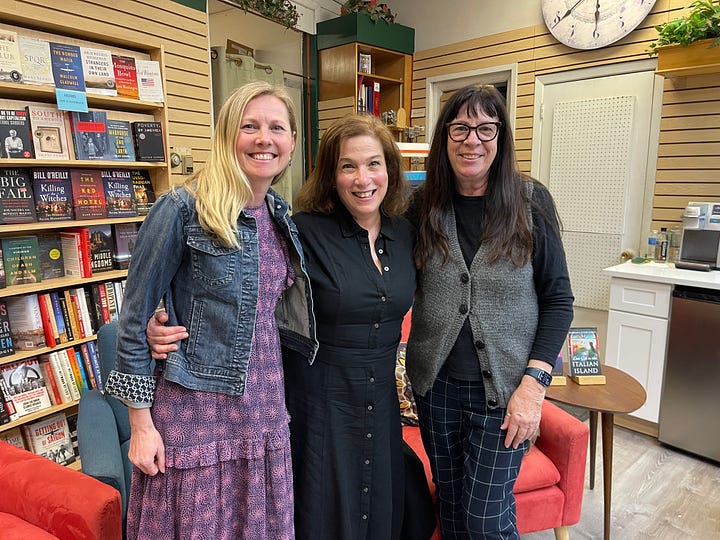
Which of your three books was the most challenging to write?
I would say that Summer Darlings was the hardest because it was my first; they say you learn how to write novels with your first book. It took me four years to write that one. But All the Summers in Between was challenging for different reasons. It was the first dual-timeline novel I’ve written, and I won’t sugarcoat it: Writing a dual timeline is brutal. It means you’re essentially writing two different novels. The first storyline is set in 1967, and the second is set in 1977, and the women are at two very different points in their lives. You have the same number of pages if you were writing one timeline, so you can’t waste a single sentence.
One thing that worked for me is that once I had the bones of the story written, I broke the timelines out into separate Word documents and worked on them as individual stories. It helped me keep track of each timeline's character arcs and allowed for a story that came full circle in both decades. Funny enough, I just wrote a second dual-timeline historical novel, my fourth book. This was just as hard. But I have to say, I love writing this way despite its challenges. It offers so much depth into a character when you’re watching them grow as the novel progresses, but you’re watching them evolve at two different points in time.
An author’s writing process fascinates me. Tell us about your writing process.
I always joke that I’m the most inefficient writer that exists—I discover so much about my characters as I write. That’s not to say I don’t start with some understanding of who they are. I always begin a novel with a premise, a plot, and a general idea of the ending. From there, I finish each chapter and ask myself: What would happen next? What would this character do at this moment knowing what I know now? That constantly evolves as time/revision goes on.
I never outline because I don’t like to reign myself in. I’ve found that creativity needs room to breathe. You have to be able to change directions without feeling stressed; you need to be able to flesh out your characters without adhering to who you thought they were when you scribbled notes on the page. Instead, I let my books unfold organically. Of course, this means I cut many scenes and rewrite chapters and dialogue is constantly changing/evolving, but I’m okay with that. It feels very similar to journalism to me. I was always rewriting and revising articles; it takes many drafts to get to the meat of what you’re trying to say.
I do a ton of research for my novels. If you get anything wrong in a historical novel, it takes the readers out of the time period, so every little detail has to be correct. I’ve spent hours interviewing members of the historical society in the Hamptons about what it was like out there before it was “The Hamptons.” It was much simpler out there, a haven for artists, writers, and money types who didn’t flash their money like they do now.
How do you decide what to write about? Do you search for storylines, or do they find you?
They find me! All three of my book ideas have landed in my lap. I had the idea for All of the Summers in Between while on a trip to Maine. We were staying at a hotel that offered a boat ride to town for dinner. On the boat ride across the shimmery harbor, I looked over and saw a pretty yellow Victorian with a young mother hanging laundry on the line while her daughter did cartwheels on the grass. I imagined a sailboat coming into the inlet in front of the house and this old friend from the past stepping onto the dock. I have no idea why, but I realized then that I wanted to tell the story of two friends: a young, restless mother and an illustrious society type with a big secret. I could see the story and the characters, even if I didn’t have all the details yet!
I got the idea for Summer Darlings from a classified real estate ad in a magazine while visiting Martha’s Vineyard, and the idea for On Gin Lane came to me when I came across a little bit of a historical tidbit while researching my first novel!
Teenage friendship plays an important role in the book. Did you have best friends in your teenage years, and are those friends still in your life today?
I noticed that you need your friends differently at various times in your life. When I was in my late teens and early twenties, I relied on my friends to fill me up inside, help me figure out my identity, and give me a sense of belonging. But I think the way you need your friends can change after you get married. You put up with a lot less when you’re older, and if someone isn’t bringing joy, it’s easier to back out of the relationship.
I’m still very close to one of my best friends from high school. But we went through a friend breakup with our third closest friend at nineteen. We were on a cross-country road trip together the summer after our freshman year of college, and after a few days driving through the south, our other friend began to pressure us to drive to a marine base in New Mexico, where her boyfriend was stationed. We did, staying in this dreadful motel in Roswell, but when she tearfully said goodbye to her boyfriend, she announced she wanted to go home. A week after leaving on the road trip of a lifetime, we were driving back to New York.
We didn’t speak for at least ten years after that. At the time, it hurt terribly that she picked her boyfriend over us, that she didn’t want the same things we wanted, and that we had to abandon this amazing trip because of her emotions. I’m not sure the same things would bother me today.
Do you find it more challenging to make friends as you get older than when you were a teen?
I’ve always found it hard to make friends because even though I am extroverted, I can be a little shy once I’m comfortable. I have more friends now than I’ve ever had in my life, but that’s because making friends when you have young children is very easy. You’re thrown together with young kids toddling around, and you have so much in common. Still, with my son a teenager, my mom friends have become lifelong friends. We’ve known each other for so long that we don’t just lunch. We travel together, go to concerts, and have a book club. We spend a lot of time talking about raising our kids and what we’re doing right or wrong, and I really need that outlet.
But I think making friends when your kids are no longer in school is much harder. Unless you have a reason to connect, how do you do it? I would think it’s a little bit like dating. You can try someone out, but it takes several meetings or more to determine if you’re compatible. It’s so much work! That’s why so many of us hold on to our friends from high school or college. Even if we’d never be friends if we met them today, we knew those friends way back when, and there’s something comforting about holding on to an old version of yourself.
Isn’t that what’s so interesting about my characters, Thea and Margot? After they reunite, Thea can acknowledge that Margot isn’t always the best friend to her, and yet, a childhood friend gives her something no one else can: a reminder of who she thought we’d be. Sometimes, friends empower us to go back and remember what we’re capable of, even after the world has beat us down.
Are any of your books biographical in any way? Are there any real-life people in your books?
Never! I can honestly say that’s the truth. I’m not someone who writes about my life, slaps a sticker on it, and calls it fiction. In my twenty years as a journalist, I interviewed hundreds of people, and I think their voices still live inside me. Some of those people make their way into my books, even though it’s unintentional. It’s more their words, a feeling they gave me, or a personality characteristic.
There are biographical elements, but nothing is that clear-cut. For example, I was a nanny in the Hamptons at nineteen, and Summer Darlings was about a nanny on Martha’s Vineyard in 1962. But I can guarantee you the people I worked for were lovely and nothing like the family in the book. It was more looking back and imagining: What if that experience had been like this?
Your book mentions several songs. Are any of those songs memorable to you in any way?
Music is such a big part of All the Summers in Between, and I think it’s because music has always been such a big part of my life. My dad was a musician, my husband is a musician, my son plays guitar, and my daughter is a pianist. (I am not a musician, I’m their biggest fan!!) No, but for real, I think music is the backdrop to our lives and often brings people together. I tried to use music in this book to show the bond that it offers people. For example, so much of Thea and her husband’s relationship was defined by their love of music, but as they age, so many other things are on their plate. Ultimately, though, a single song brings them back together. Well, among many other things.
What are you reading now, and do you have any books to recommend to readers?
Yes! I always have books to recommend to readers. I’m loving The Titanic Survivor’s Book Club. I’m starting Real Americans, which is on everyone’s must-read list, and I cannot wait for Elin Hilderbrand’s last Nantucket summer novel, Swan Song. I love Elin’s books, and she’s been so generous to me over the years. When I read the acknowledgments in her latest book, I teared up. That probably makes me sound like a crazy person, but it was such an authentic thank you. It got me.

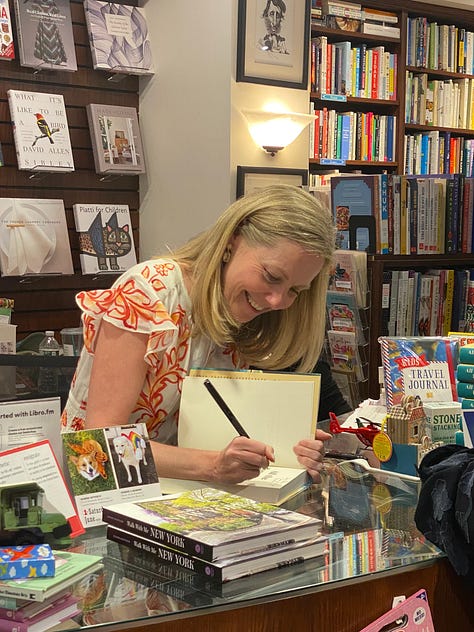
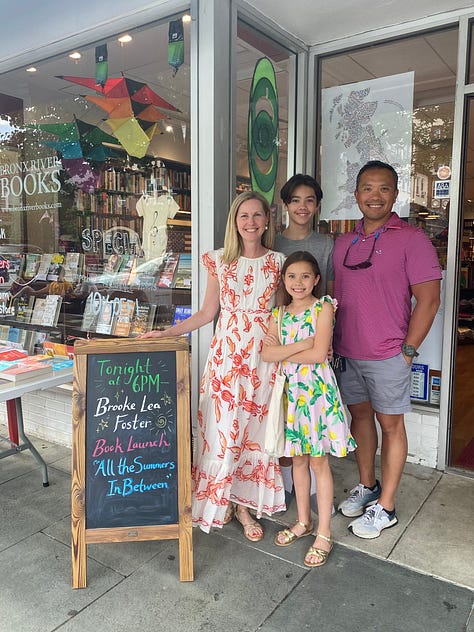
Can you tell us what's coming up next for you?
I’m leaving for a 22-event book tour this week. Woot! I also just finished my fourth novel. This one is about an old Washington political family, and it’s set in Martha’s Vineyard in 1965 and 1978. It may be my favorite one yet.
Brook is active on social media, and you can find her at the following places: Website | Newsletter | Instagram | Facebook | TikTok. Her newsletter is a joy to read; there is lots of bookish content, author interviews, and more about her writing life.
Readers, if you are on the East Coast from South Carolina to Massachusetts, you have several opportunities to see Brooke in person and visit independent bookstores along the way. Some events require registration, others are ticketed, and many are free.
Brooke, thank you so much for the opportunity to get to know you and learn more about your books. I’ve read and enjoyed all of them. Your books are my favorite kind of historical fiction to read, and I can’t wait to see how you combine politics and family for another great beachy read.
Here’s to a wonderful book tour! I’m sad that you aren’t coming to my area, but I have registered for the ”What’s New in Historical Fiction” panel in a couple of weeks, and I’ll get a taste of your book tour then.
Some of the links in this newsletter may be affiliate links. That means that if you click through and purchase anything, I may earn a small commission. This costs you nothing and helps me feed my voracious reading habit, and for that, I thank you.

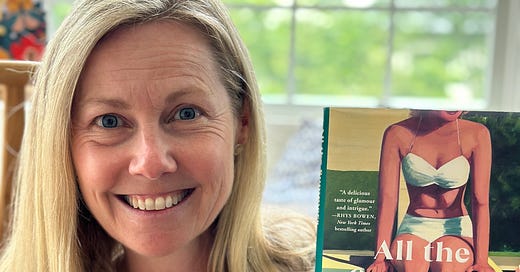



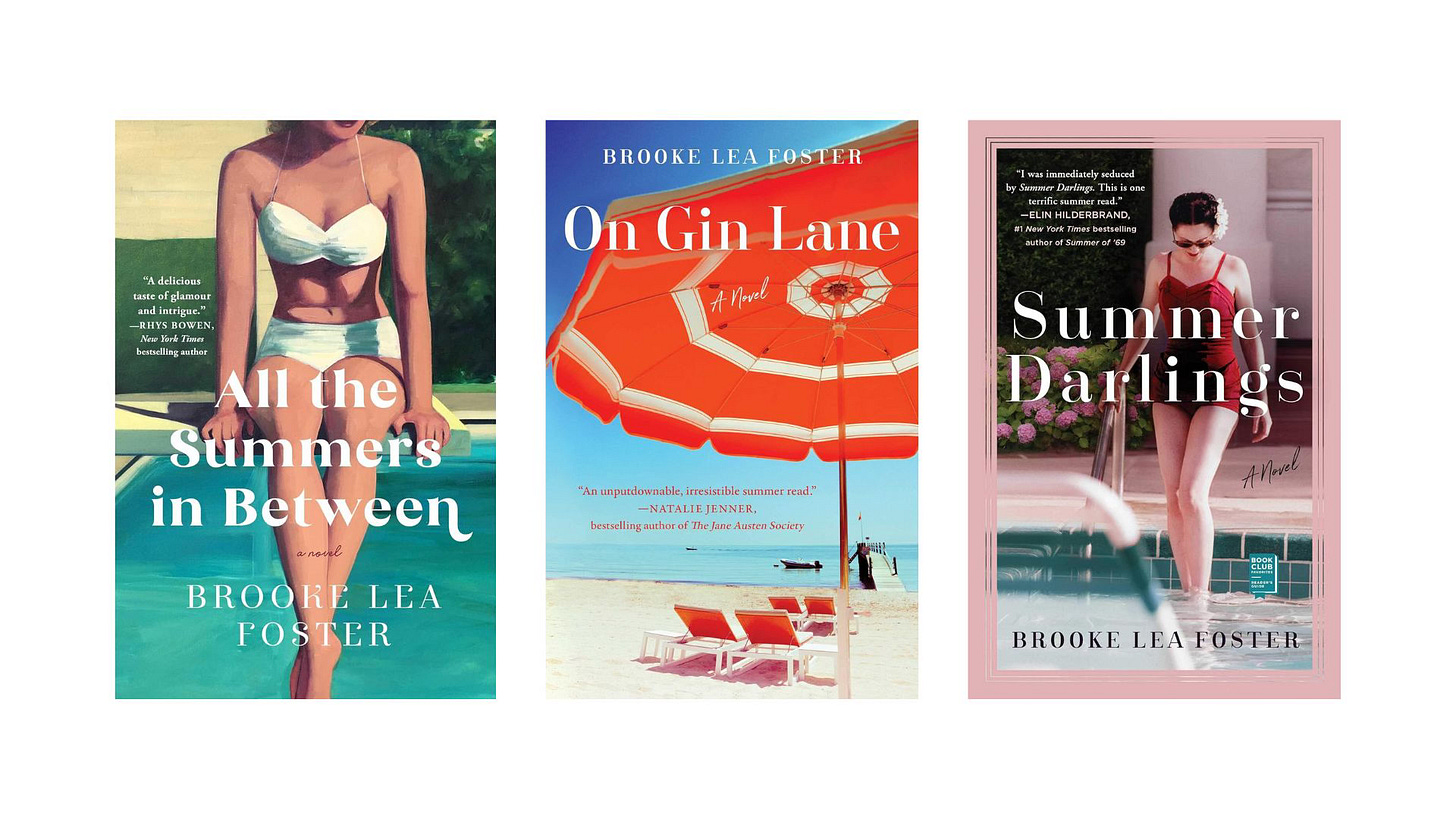
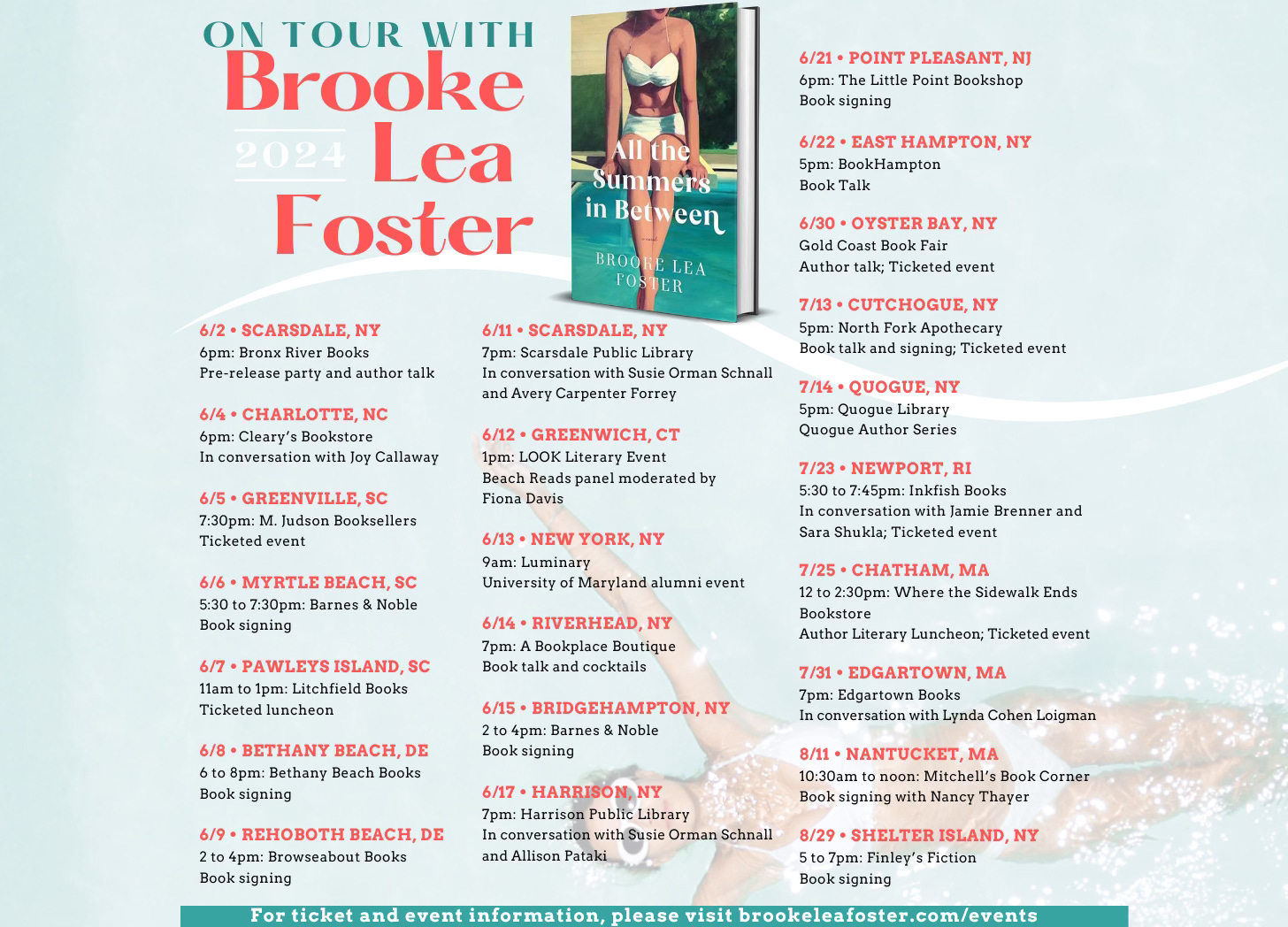

I love this interview. This is a new author for me, completely different than something I'd choose to read. But the interview was so good it led me in and now I'm excited with a new find! Best of luck to the author on her book tour, and Gayla, you never disappoint! Thank you!
I really enjoyed this interview, Gayla and Brooke!
Thank you for this behind the scenes peak.